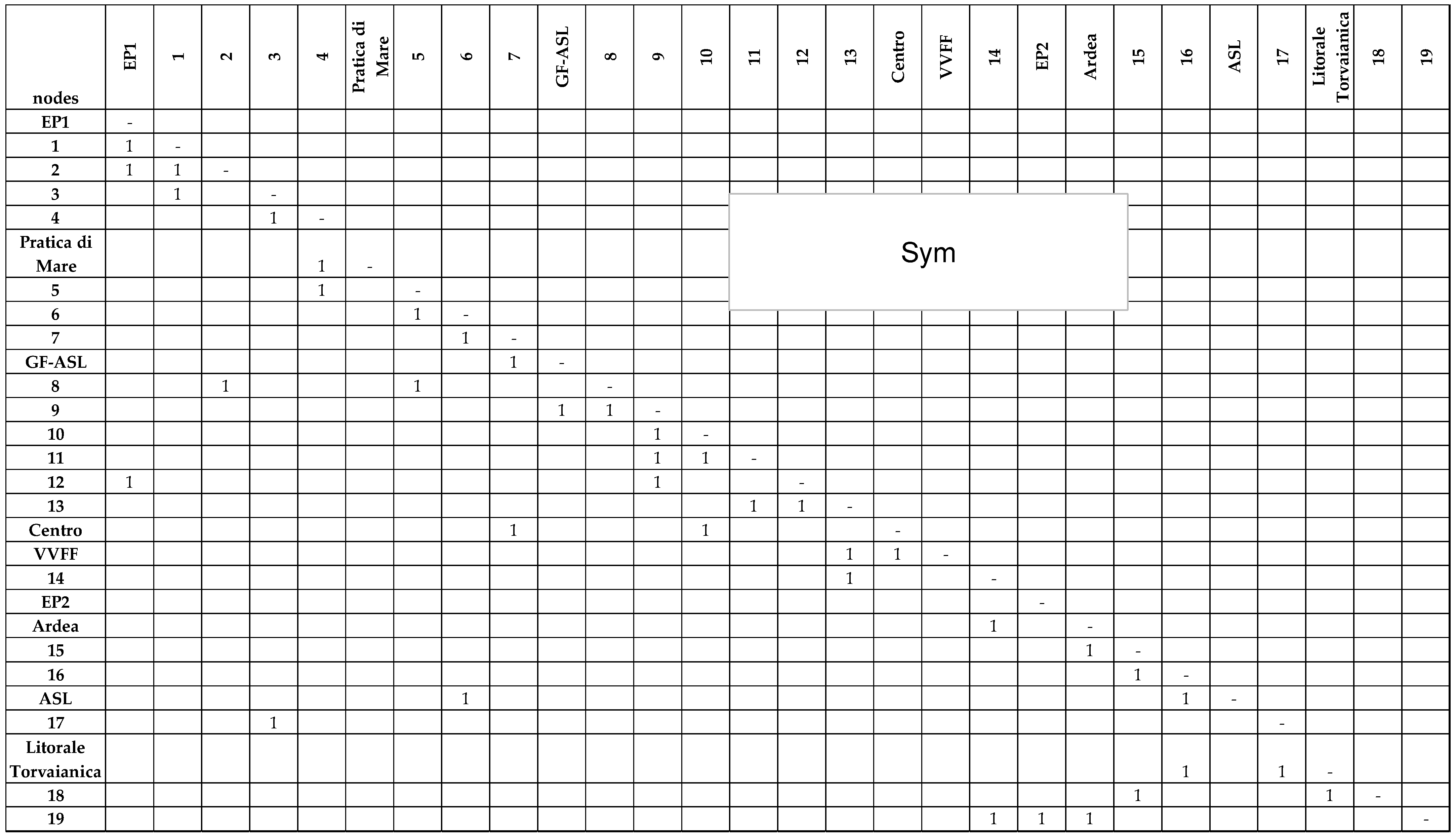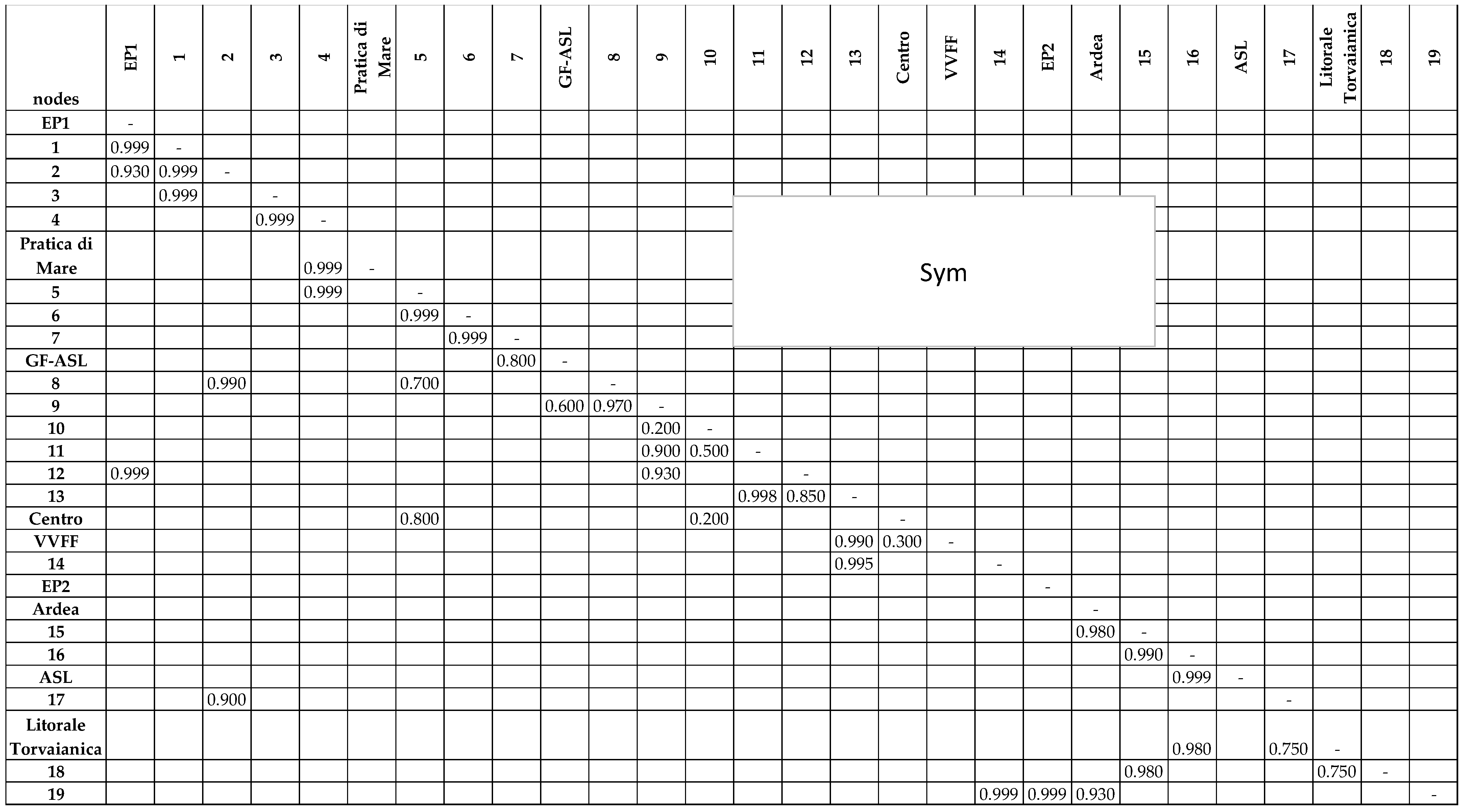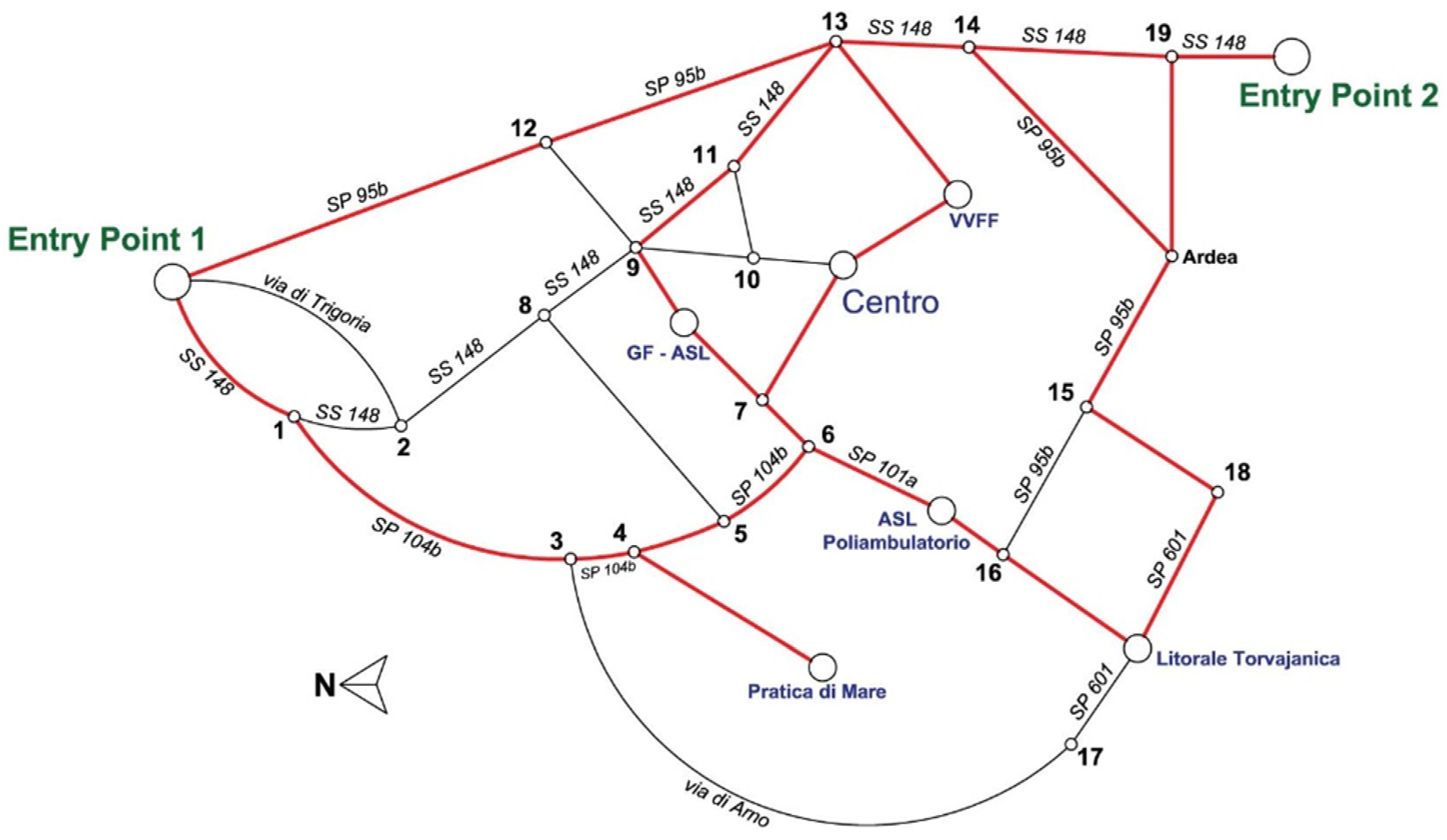Consistency of Urban Roads to Manage Emergencies: Methodology to Identify the Minimum Network with Total Connectivity at Maximum Availability
Abstract
:1. Introduction
1.1. Natural Risks and Urban Development
1.2. Risk Analysis
1.3. Minimum Urban Structure
2. Methods
- all the arcs have been sorted in descending order of dij;
- the network topology of the first n-1 arcs has been analyzed in order to verify if it was complete (i.e., there was a path between every pair of vertices). If at least one node or strategical building was not included in the identified network, the graph was re-analyzed to modify its configuration and link all the nodes/strategical buildings.
3. Case Study and Results
- Entry Point 1 (EP1): a safe open space 17 km from Pomezia where logistical support and rescue services from the north could be hosted;
- Entry Point 2 (EP2): the second headquarters 15 km from Pomezia where logistical support and rescue services from the south could be hosted;
- GF-ASL: three strategic buildings (i.e., a health unit, a pharmacy, and the board of the Customs corps) are in this area;
- Centro: there are four strategic buildings (i.e., the town hall, the police office, the board of the local police, and a pharmacy);
- VVFF: hosts a fire station,
- ASL: hosts a health facility;
- Pratica di Mare: a military area where there is an airport;
- Litorale Torvajanica: includes five strategic buildings (i.e., two pharmacies, two police offices, and a fire station).
- geometric characteristics (e.g., carriageway width, and longitudinal slopes);
- net paths compliant with the width of emergency vehicles: enrolling in curves with small radius should ensure the residual functionality (i.e., availability”) after a seismic event;
- MUS connection to two peripheral entry points where rescue services would be placed.
4. Discussion
5. Conclusions
Author Contributions
Funding
Institutional Review Board Statement
Informed Consent Statement
Data Availability Statement
Acknowledgments
Conflicts of Interest
References
- Lawton, P. Tracing the provenance of urbanist ideals: A critical analysis of the Quito papers. Int. J. Urban Reg. Res. 2020, 44, 731–742. [Google Scholar] [CrossRef]
- Galiano, G.; Cutini, A. Guida alla Pianificazione Territoriale; Edizioni Efesto: Rome, Italy, 2020; EAN: 9788833812311. [Google Scholar]
- Cappuccitti, A. Earthquake, urban form and city planning: Research perspectives. CSE J. City Saf. Energy 2014, 2, 15–27. [Google Scholar]
- De Rubeis, A.; Di Mascio, P.; Montanarelli, F.; Moretti, L. Design of a temporary surface-level helipad paved with aluminium mats. Eur. Transp. Trasp. Eur. 2019, 72, 5. [Google Scholar]
- Kumar, A. Natural hazards of the Arabian Peninsula: Their causes and possible remediation. In Earth System Processes and Disaster Management; Sinha, R., Ravindra, R., Eds.; Springer: Berlin/Heidelberg, Germany, 2013; pp. 155–180. [Google Scholar]
- Forester, J. Pianificazione e Potere. Pratiche e Teorie Interattive del Progetto Urbano, 1st ed.; Dedalo: Bari, Italy, 1998; EAN: 9788822061843. [Google Scholar]
- Romano, B. Pianificazione Sostenibile del Territorio, 1st ed.; Verdone: Biella, Italy, 2014. [Google Scholar]
- Bertino, G.; Fischer, T.; Puhr, G.; Langergraber, G.; Österreicher, D. Framework Conditions and Strategies for Pop-Up Environments in Urban Planning. Sustainability 2019, 11, 7204. [Google Scholar] [CrossRef] [Green Version]
- Morrow, B. Identifying and mapping community vulnerability. Disasters 1999, 23, 1–18. [Google Scholar] [CrossRef] [PubMed]
- Bostenaru Dan, M. Decision Making Based on Benefit-Costs Analysis: Costs of Preventive Retrofit versus Costs of Repair after Earthquake Hazards. Sustainability 2018, 10, 1537. [Google Scholar] [CrossRef] [Green Version]
- Akadiri, P.O.; Chinyio, E.A.; Olomolaiye, P.O. Design of A Sustainable Building: A Conceptual Framework for Implementing Sustainability in the Building Sector. Buildings 2012, 2, 126–152. [Google Scholar] [CrossRef] [Green Version]
- Sucuoğlu, H.; Yakut, A.; Özmen, A.; Kubin, J. Seismic Risk Prioritization and Retrofit Cost Evaluation of Code-Deficient RC Public Buildings in Turkey. Earthq. Spectra 2015, 31, 601–614. [Google Scholar] [CrossRef]
- Franchin, P. Methodology for Systemic Seismic Vulnerability Assessment of Buildings, Infrastructures, Networks and Socio-Economic Impacts, SYNER-G Reference Report 1; Publications Office of the European Union: Luxembourg, 2013. [Google Scholar] [CrossRef]
- Colavitti, A.M.; Floris, A.; Serra, S. Urban Standards and Ecosystem Services: The Evolution of the Services Planning in Italy from Theory to Practice. Sustainability 2020, 12, 2434. [Google Scholar] [CrossRef] [Green Version]
- Cirianni, F.; Fonte, F.; Leonardi, G.; Scopelliti, F. Analysis of Lifelines Transportation Vulnerability. Procedia-Soc. Behav. Sci. 2012, 53, 29–38. [Google Scholar] [CrossRef] [Green Version]
- Moretti, L.; Loprencipe, G. Climate change and transport infrastructures: State of the art. Sustainability 2018, 10, 4098. [Google Scholar] [CrossRef] [Green Version]
- Solari, D.; Cimellaro, G.P. A comprehensive methodology for the evaluation of infrastructure interdependencies. Urban Resil. Emerg. Response Recovery 2016, 41, 139–223. [Google Scholar]
- Li, Z.; Liu, Q. Optimal deployment of emergency rescue stations in an urban transportation corridor. Transportation 2020, 47, 445–473. [Google Scholar] [CrossRef]
- Su, D.; Guo, Z.; Liu, B. Traffic function loss of highway lifelines during major natural disasters. In Proceedings of the 4th International Conference on Transportation Engineering, ICTE 2013, Chengdu, China, 19–20 October 2013; pp. 2598–2604. [Google Scholar]
- Franchin, P.; Pinto, P.E. Allowing traffic over mainshock-damaged bridges. J. Earthq. Eng. 2009, 13, 585–599. [Google Scholar] [CrossRef]
- Indovina, F. Governare la Città con L’urbanistica; Maggiori Editore: Rimini, Italy, 2013. [Google Scholar]
- Banba, M.; Shaw, R. Land Use Management in Disaster Risk Reduction. Practice and Cases from a Global Perspective; Springer Japan: Chiyoda-ku, Japan; ISBN 978-4-431-56442-3.
- Aragona, S. Ecological resilience and care of the common house to build the landscape of contemporaneity and future scenarios of territories and cities. In New Metropolitan Perspectives. Local Knowledge and Innovation Dynamics towards Territory Attractiveness through the Implementation of Horizon/E2020/Agenda2030; Springer International Publishing: Heidelberg, Germany, 2018; pp. 522–533. ISBN 978-3-319-92099-3. [Google Scholar] [CrossRef]
- Italian Parliament. Disposizioni urgenti per il riordino della protezione civile. Decreto-Legge n. 59/2012, 15 May 2012. [Google Scholar]
- Muller, J.; Dame, J. Small Town, Great Expectations: Urbanization and Beautification in Leh. South Asia Multidiscip. Acad. J. 2016, 14, 4208. [Google Scholar] [CrossRef] [Green Version]
- Iida, Y.; Kurauchi, F.; Shimada, H. Traffic management system against major earthquakes. IATSS Res. 2000, 24, 6–17. [Google Scholar] [CrossRef] [Green Version]
- National Academies of Sciences, Engineering, and Medicine. A Guide to Regional Transportation Planning for Disasters, Emergencies, and Significant Events; The National Academies Press: Washington, DC, USA, 2014. [Google Scholar] [CrossRef] [Green Version]
- Galiano, G.; Cutini, A. Il pianificatore: Mediatore tra politica e bisogni dei cittadini-uno sguardo all’edilizia pubblica. In Gli Attori del Divenire Urbano, Proceedings of the 1st Congress on Interaction Man-Space-Time, Rome, Italy, 26 November 2015; Efesto: Rome, Italy, 2016; pp. 5–15, ISBN/ISSN: 9788899104801. [Google Scholar]
- Forestieri, G.; Marseglia, G.; Galiano, G. Recovery and optimization of a former railway transport track. WIT Trans. Built Environ. 2019, 186, 47–57. [Google Scholar] [CrossRef] [Green Version]
- Forestieri, G.; Galiano, G. Sustainable transport network for the urban rehabilitation of an old town in southern Italy. WIT Trans. Built Environ. 2019, 182, 229–239. [Google Scholar] [CrossRef] [Green Version]
- Franchin, P.; Lupoi, A.; Pinto, P.E. On the role of road network in reducing human losses after earthquakes. J. Earthq. Eng. 2006, 10, 195–206. [Google Scholar] [CrossRef]
- Fabietti, V.; Pozzi, C. The Minimum Urban Structure. Architectural Culture and Society. Space International Conference 2019; Editor SPACE Studies of Planning and Architecture Ltd.: London, UK, 2019; ISBN 9781916284111. [Google Scholar]
- Dijkstra, L.; Poelman, H. Cities in Europe—The New OECD-EC Definition. Available online: https://ec.europa.eu/regional_policy/sources/docgener/focus/2012_01_city.pdf (accessed on 7 October 2021).
- Ordinanza del Presidente del Consiglio dei Ministri (OPCM) n.3519. Criteri Generali per L’individuazione delle Zone Sismiche e per la Formazione e L’aggiornamento Degli Elenchi delle Medesime Zone. Gazzetta Ufficiale n.108 dell’11 Maggio 2006. Available online: http://www.protezionecivile.gov.it/amministrazione-trasparente/provvedimenti/dettaglio/-/asset_publisher/default/content/opcm-n-3519-del-28-aprile-2006-criteri-generali-per-l-individuazione-delle-zone-sismiche-e-per-la-formazione-e-l-aggiornamento-degli-elenchi-delle-ste (accessed on 4 September 2021). (In Italian)
- Guze, S. Graph Theory Approach to Transportation Systems Design and Optimization. TransNav Int. J. Mar. Navig. Saf. Sea Transp. 2014, 8, 571–578. [Google Scholar] [CrossRef] [Green Version]
- Thomson, R.C.; Ricardson, D.E. A graph theory approach to road network generalization. In Proceedings of the 17th International Cartographic Conference, Barcelona, Spain, 3–9 September 1995; pp. 1871–1880. [Google Scholar]
- Courtat, T.; Gloaguen, C.; Douady, S. Mathematics and morphogenesis of cities: A geometrical approach. Phys. Rev. 2011, E83, 036106. [Google Scholar] [CrossRef] [Green Version]
- Argyroudis, S.; Selva, J.; Gehl, P.; Pitilakis, K. Systemic Seismic Risk Assessment of Road Networks Considering Interactions with the Built Environment. Comput.-Aided Civ. Infrastruct. Eng. 2015, 30, 524–540. [Google Scholar] [CrossRef]
- Goretti, A.; Sarli, V. Road network and damaged buildings in urban areas: Short and long-term interaction. Bull. Earthq. Eng. 2006, 4, 159–175. [Google Scholar] [CrossRef]
- Schweier, C.; Markus, M. Classification of collapsed buildings for fast damage and loss assessment. Bull. Earthq. Eng. 2006, 4, 177–192. [Google Scholar] [CrossRef]
- Grünthal, G. Cahiers du Centre Européen de Géodynamique et de Séismologie: Volume 15—European Macroseismic Scale 1998; European Center for Geodynamics and Seismology: Luxembourg, 1998. [Google Scholar]
- Jarry, A.; Laugier, A. On the minimum number of edges of two-connected graphs with given diameter. Discret. Math. 2012, 312, 757–762. [Google Scholar] [CrossRef] [Green Version]
- Cantisani, G.; Del Serrone, G. Procedure for the identification of existing roads alignment from georeferenced points database. Infrastructures 2021, 6, 2. [Google Scholar] [CrossRef]





| Criterion | Vulnerability Class | ||||
|---|---|---|---|---|---|
| Very Low | Low | Moderate | High | Very High | |
| embankment height (m) | <1 | 1–3 | 3–5 | >5 with berm | >5 without berm |
| natural soil slope (%) | <10 | 10–15 | 15–20 | >20 with benching | >20 without benching |
| maximum side slope (%) | <2/3 | =2/3 | =2/3 | >2/3 | >2/3 |
| shoulder width (m) | <0.5 | 0.5–1 | 0.5–1 | >1 | > 1 |
| natural soil | silt | clay | granular soil | fractured rock | intact rock |
| Criterion | Vulnerability Class | ||||
|---|---|---|---|---|---|
| Very Low | Low | Moderate | High | Very High | |
| trench height (m) | <1 | 1–3 | 3–6 | 6–9 | >9 |
| maximum side slope (%) | <1/1 | =1/1 | =1/1 | >1/1 with protection | >1/1 without protection |
| shoulder width (m) | <0.5 | 0.5–1 | 0.5–1 | >1 | >1 |
| natural soil | silt | clay | granular soil | fractured rock | intact rock |
| ki,j,s | Most Frequent or Best Vulnerability Class |
|---|---|
| 0.2 | very high |
| 0.4 | high |
| 0.6 | moderate |
| 0.8 | low |
| 1 | very low |
| Type of Structure | Structure Type | BDI | ||||
|---|---|---|---|---|---|---|
| 0.15–0.25 | 0.35–0.45 | 0.55–0.65 | 0.75–0.85 | 0.95–1 | ||
| Masonry | dry masonry | x | ||||
| simple stone | x | |||||
| unreinforced with reinforced concrete floors | x | |||||
| massive stone/reinforced or confined | x | |||||
| Reinforced concrete | structures without earthquake-resistant design (ERD) | x | ||||
| structures with moderate level of ERD | x | |||||
| structures with high level of ERD | x | |||||
| Steel structures | x | |||||
| Timber structures | - | x | ||||
| Scenario | ki,j,f |
|---|---|
| furniture’s collapse occupies the carriageway and disrupts circulation | 0.2 |
| furniture’s collapse occupies a large part of carriageway permitting only one-way circulation | 0.4 |
| furniture’s collapse occupies only shoulders | 0.6 |
| furniture’s collapse occupies only road margins | 0.8 |
| no effects of furniture’s collapse or no furniture on the road | 1.0 |
| # | Arc | Availability | # | Arc | Availability | ||
|---|---|---|---|---|---|---|---|
| 1 | EP1–12 | 0.999 | 1 | EP1–12 | 0.999 | ||
| 2 | 1–2 | 0.999 | 2 | 1–2 | 0.999 | ||
| 3 | 1–3 | 0.999 | 3 | 1–3 | 0.999 | ||
| 4 | 3–4 | 0.999 | 4 | 3–4 | 0.999 | ||
| 5 | 4–5 | 0.999 | 5 | 4–5 | 0.999 | ||
| 6 | 5–6 | 0.999 | 6 | 5–6 | 0.999 | ||
| 7 | 6–7 | 0.999 | 7 | 6–7 | 0.999 | ||
| 8 | 14–19 | 0.999 | 8 | 14–19 | 0.999 | ||
| 9 | EPZ–19 | 0.999 | 9 | EPZ–19 | 0.999 | ||
| 10 | EP1–1 | 0.999 | 10 | EP1–1 | 0.999 | ||
| 11 | 4–Pratica di Mare | 0.999 | 11 | 4–Pratica di Mare | 0.999 | ||
| 12 | 6–ASL | 0.999 | 12 | 6–ASL | 0.999 | ||
| 13 | 16–ASL | 0.999 | 13 | 16–ASL | 0.999 | ||
| 14 | 11–13 | 0.998 |  | 14 | 11–13 | 0.998 | |
| 15 | 13–14 | 0.995 | 15 | 13–14 | 0.995 | ||
| 16 | 2–8 | 0.990 | 16 | 2–8 | 0.990 | ||
| 17 | 13–VVF | 0.990 | 17 | 13–VVF | 0.990 | ||
| 18 | 14–Ardea | 0.990 | 18 | 14–Ardea | 0.990 | ||
| 19 | 15–16 | 0.990 | 19 | 15–16 | 0.990 | ||
| 20 | Ardea–15 | 0.980 | 20 | Ardea–15 | 0.980 | ||
| 21 | 15–18 | 0.980 | 21 | 15–18 | 0.980 | ||
| 22 | 16–Litorale Torvajanica | 0.980 | 22 | 16–Litorale Torvajanica | 0.980 | ||
| 23 | 8–9 | 0.970 | 23 | 8–9 | 0.970 | ||
| 24 | EP1–2 | 0.930 | 24 | EP1–2 | 0.930 | ||
| 25 | 9–12 | 0.930 | 25 | 9–12 | 0.930 | ||
| 26 | Ardea–19 | 0.930 | 26 | Ardea–19 | 0.930 | ||
| 27 | 3–17 | 0.900 | 27 | 3–17 | 0.900 | ||
| 28 | 9–11 | 0.900 | 28 | 9–11 | 0.900 | ||
| 29 | 12–13 | 0.850 | 29 | 12–13 | 0.850 | ||
| 30 | 7–GF,ASL | 0.800 | 30 | 7–GF,ASL | 0.800 | ||
| 31 | 7–Centro | 0.800 | 31 | 7–Centro | 0.800 | ||
| 32 | 17–Litorale Torvajanica | 0.750 | 32 | 17–Litorale Torvajanica | 0.750 | ||
| 33 | Litorale Torvajanica–18 | 0.750 | 33 | Litorale Torvajanica–18 | 0.750 | ||
| 34 | 5–8 | 0.700 | 34 | 5–8 | 0.700 | ||
| 35 | GF,ASL–9 | 0.600 | 35 | GF,ASL–9 | 0.600 | ||
| 36 | 10–11 | 0.500 | 36 | 10–11 | 0.500 | ||
| 37 | Centro–VVFF | 0.300 | 37 | Centro–VVFF | 0.300 | ||
| 38 | 9–10 | 0.200 | 38 | 9–10 | 0.200 | ||
| 39 | 10–Centro | 0.200 | a | 39 | 10–Centro | 0.200 | b |
| Departure Entry Point | Destination Focal Area | Intermediate Nodes | tkl |
|---|---|---|---|
| EP1 | Pratica di Mare | 1-3-4 | 0.867 |
| 2-8-5-4 | 0.017 | ||
| 12-13-14-19-Ardea-15-16-ASL-6-5-4 | 0.003 | ||
| GF,ASL | 1-3-4-5-6-7 | 0.135 | |
| 1-3-4-5-8-9 | 0.004 | ||
| 1-2-8-5-6-7 | 0.011 | ||
| 1-2-8-9 | 0.017 | ||
| 12-9 | 0.030 | ||
| 12-13-11-9 | 0.003 | ||
| VVF | 1-2-8-9-11-13 | 0.010 | |
| 12-13 | 0.086 | ||
| 1-3-4-5-6-ASL-16-15-Ardea-14-13 | 0.020 | ||
| Centro | 1-3-4-5-6-7 | 0.129 | |
| 1-2-8-9-GF-7 | 0.0004 | ||
| 1-2-8-9-11-13-VVF | 0.001 | ||
| 12-9-GF-7 | 0.001 | ||
| 12-9-11-13-VVF | 0.001 | ||
| ASL | 1-3-4-5-6 | 0.711 | |
| 1-2-8-9-11-13-14-Ardea-15-16 | 0.001 | ||
| 12-13-14-Ardea-15-16 | 0.009 | ||
| Litorale Torvajanica | 1-3-17 | 0.030 | |
| 1-3-4-5-6-ASL-16 | 0.170 | ||
| 12-13-14-Ardea-15-16 | 0.003 | ||
| 12-13-14-Ardea-15-18 | 0.001 | ||
| EP2 | Litorale Torvajanica | 19-Ardea-15-16 | 0.014 |
| 19-Ardea-15-18 | 0.005 | ||
| VVF | 19-14-13 | 0.301 | |
| 19-Ardea-14-13 | 0.032 | ||
| Centro | 19-14-13-VVF | 0.017 | |
| 19-Ardea-15-16-ASL-6-7 | 0.004 | ||
| ASL | 19-Ardea-15-16 | 0.035 | |
| 19-14-Ardea-15-16 | 0.080 | ||
| GF,ASL | 19-14-Ardea-15-16-ASL-6-7 | 0.010 | |
| 19-14-13-12-9 | 0.003 | ||
| 19-14-13-11-9 | 0.012 | ||
| Pratica di Mare | 19-14-Ardea-15-16-ASL-6-5-4 | 0.060 |
Publisher’s Note: MDPI stays neutral with regard to jurisdictional claims in published maps and institutional affiliations. |
© 2021 by the authors. Licensee MDPI, Basel, Switzerland. This article is an open access article distributed under the terms and conditions of the Creative Commons Attribution (CC BY) license (https://creativecommons.org/licenses/by/4.0/).
Share and Cite
Galiano, G.; Moretti, L. Consistency of Urban Roads to Manage Emergencies: Methodology to Identify the Minimum Network with Total Connectivity at Maximum Availability. Sustainability 2021, 13, 11151. https://doi.org/10.3390/su132011151
Galiano G, Moretti L. Consistency of Urban Roads to Manage Emergencies: Methodology to Identify the Minimum Network with Total Connectivity at Maximum Availability. Sustainability. 2021; 13(20):11151. https://doi.org/10.3390/su132011151
Chicago/Turabian StyleGaliano, Giuseppe, and Laura Moretti. 2021. "Consistency of Urban Roads to Manage Emergencies: Methodology to Identify the Minimum Network with Total Connectivity at Maximum Availability" Sustainability 13, no. 20: 11151. https://doi.org/10.3390/su132011151







